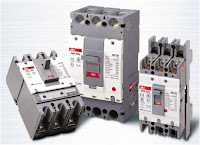direct current electrical motor DC motors /
direct current, as the name implies, uses a direct current indirect / direct-unidirectional. DC motors are used in special applications where high torque ignition or acceleration over a broad speed range.this is another article about
electric motor while we have discuss
alternating current electrical motor.
Figure 3 shows a DC motor which has three main components:
• Pole field. Simply put, the interaction of the two magnetic poles will cause the rotation of a DC motor. DC motor has a stationary field poles and armature that moves in the space between the poles bearing field. A simple DC motor has two field poles: north and south poles. The magnetic lines of force extend across the opening between the poles from north to south. For motors larger or more complex consists of one or more electromagnets. Electromagnetic receive electricity from an outside power source as the field structure.
• Dinamo. If the current goes through the armature, it will become an electromagnet. Cylindrical dynamo, connected to the countershaft to drive the load. For the case of a small DC motor, the armature rotates in a magnetic field formed by the poles, to the north and south magnetic poles change locations. If this happens, the current is reversed to switch poles north and south dynamo.
• commutator. This component is mainly found in DC motors. Its purpose is to reverse the direction of the electric current in the armature. commutator also helps in the transmission of current between the armature and resources.
The main advantage is the speed of DC motor is easy to control and does not affect the quality of power supply. DC motors can be controlled by adjusting:
• armature voltage - increasing the armature voltage will increase the speed.
• Flow field - reducing the field current will increase the speed.
DC motors are available in many sizes, but their use is generally limited to a few low speed, low to moderate power usage, such as machine tools and rolling mills because of problems with mechanical commutation at a larger size. Also, they are restricted for use only in areas that are clean and not dangerous because the risk of sparking at the brushes. DC motors are also relatively expensive compared to AC motors.
The relationship between speed, field flux and armature
voltage is shown in the following equation:
Electromagnetic force: E = KΦN
Torque: T = KΦIa
Where:
E = electromagnetic force developed in the armature terminals (volts)
Φ = flux field is directly proportional to the field current
N = speed in RPM (revolutions per minute)
T = torque electromagnetic
Ia = armature current
K = constant equation
DC Motor Types / Unidirectional Flow
a. Separate power DC motor / Separately Excited, If the field current is supplied from a separate source, it is called a separate power source DC motor / separately excited.
b. DC motors own resources / Self Excited: shunt motor. In a shunt motor, the field winding (shunt field) is connected in parallel with the armature winding (A). Therefore the total line current is the sum of the field current and armature current.
Here's about the speed of a shunt motor (ETE, 1997):
• Speed is not constant in practice depends on the load (up to a certain torque as speed decreases, see Figure 4) and is therefore suitable for commercial use with a low initial load, such as machine tools.
• Speed can be controlled by inserting resistance in series with the armature arrangement (reduced rate) or by inserting resistance in the field current (increasing speed).
c. Own power DC motors: motor series. In a series motor, the field winding (shunt field) connected in series with the armature winding (A). Therefore, the same field current to the armature current.
Here's about the speed of the motor series (Rodwell International Corporation, 1997; LM Photonics Ltd, 2002):
• Speed is limited to 5000 RPM.
• It must be avoided running series motor with no load because the motor will accelerate.
Series motors are suitable for applications that require high starting torque, such as cranes and hoists.
d. Motor DC Compound / Combined.
DC compound motor is a combination of series and shunt motors. In this motor, the field winding (shunt field) connected in parallel and in series with the armature winding (A) as shown in Figure 6. Thus, the motor has a starting torque nice and steady pace. The higher the percentage of incorporation (ie, percentage of field windings are connected in series), the higher starting torque that can be handled by this motor. For example, the incorporation of 40-50% makes the motor suitable for hoists and cranes, motors standard compound (12%) do not match
fuft..thats LOL all article about
electric is make me addict but its fun to share with all readers,thanks


